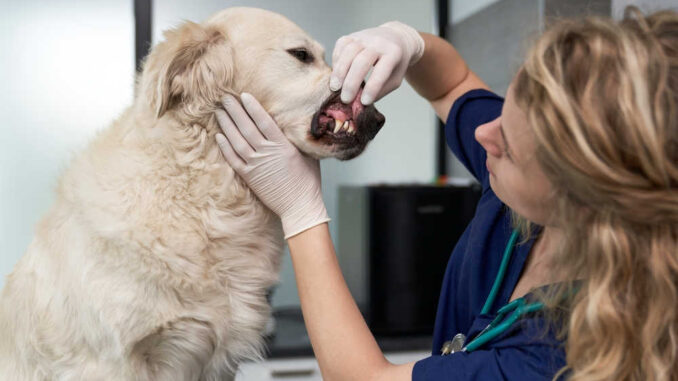
This article was updated on June 29th, 2023
One day I had a call from a client who found a small bump on her dog’s gums while she was brushing his teeth. I explained there are various causes of gum growths, bumps and lumps (sometimes growing over the teeth) and suggested she bring her dog to the clinic for a dental exam. In this article, I’ll explain the major types of bumps that can grow over a dog’s teeth, what they look like, and what causes them. Then, I’ll give you some things you can try at home and signs that it’s time to head to your veterinarian.
What do gum bumps and growths look like? (with pictures)
Different bumps and growths in your dog’s mouth aren’t normal, but it helps to know what the different types look like.
1. Gingival hyperplasia
Usually occurring with periodontal disease or with the administration of certain drugs, gingival hyperplasia involves overgrowth of the gum tissue. The condition is characterized by firm swelling of the gums. It may be localized and look like a tumor or generalized. There may also be redness and inflammation. In severe cases, the overgrowth may cover the teeth.
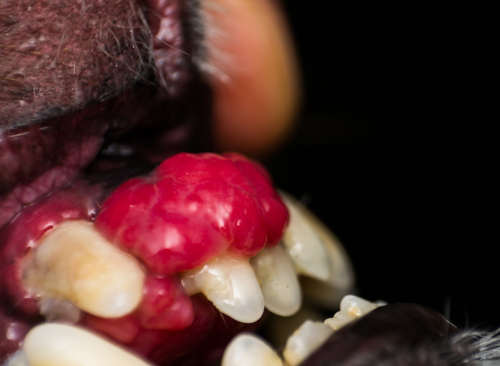
2. Canker sore/ulcer
Ulceration or sores in the mouth aren’t always noticeable, but you may see inflammation of the gum tissue, ulcers where the gums meet the lips, and whitish-gray dead tissue around the depression.
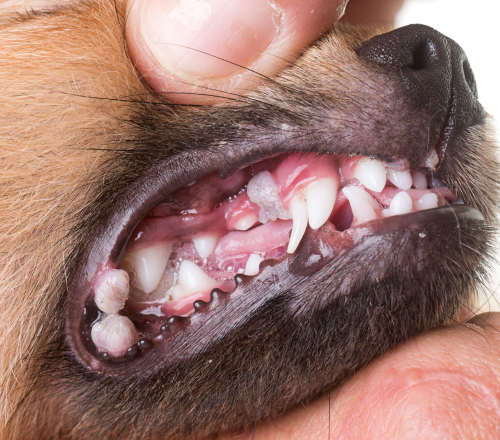
3. Tooth root abscess
When a pocket of infection develops under the gumline at the root of a tooth, you may notice swollen red gums, swelling around the face, and possibly a draining wound on the face or in the mouth. You may also notice dental tartar, gingivitis, or a fractured tooth.
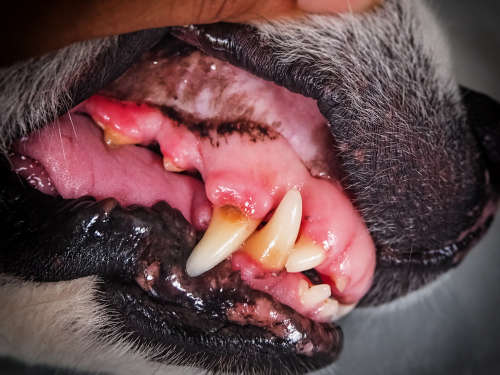
4. Dental cyst
When a tooth fails to erupt, a cyst or fluid-filled sac may form over the area. You will notice a soft swelling around the area of a missing tooth.
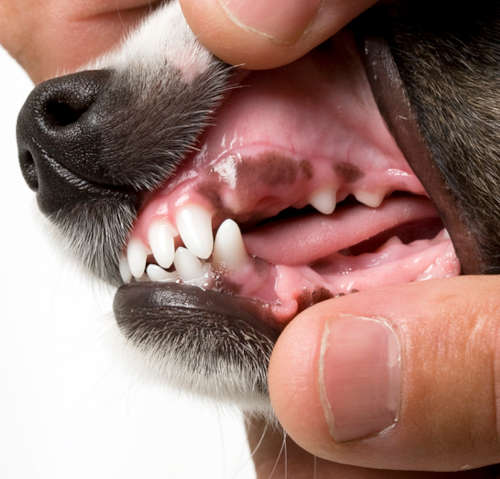
5. Peripheral odontogenic fibromas (POF)
Also known as gum boils, POFs are benign, slow-growing masses that can form in the gums near the teeth and over the teeth. These masses are usually firm, singular, and colored like the surrounding gums.
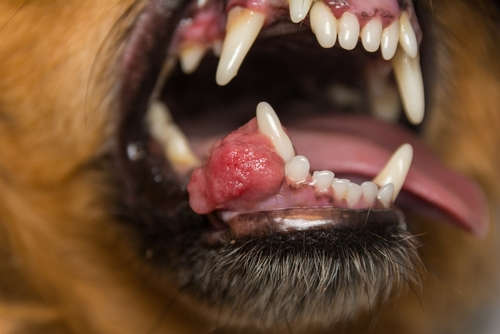
6. Acanthomatous ameloblastoma
Although these tumors don’t metastasize, they are locally invasive and exhibit aggressive growth. Acanthomatous ameloblastomas usually occur at the front of the part of the lower jaw, and they arise from the periodontal ligament.
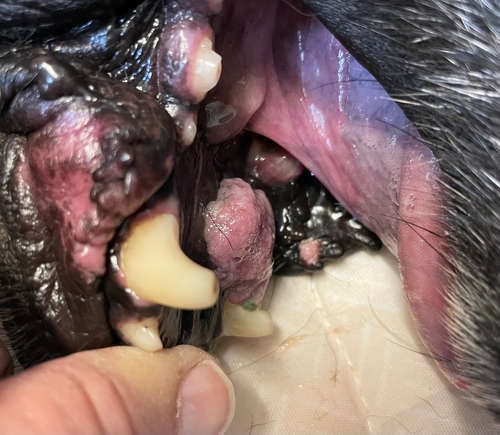
7. Odontoma
Found more commonly in puppies, odontomas arise from bone tissue and may have bone cells. These masses are non-ulcerated, smooth, and pink in color. Click here to view an odontoma picture (figure 1).
8. Melanoma
Oral melanomas are the most common type of melanoma in dogs. This tumor is aggressive, invasive, and malignant. Usually, the melanocytes will cause a black or dark pigmentation of the growth, as shown on the image below.
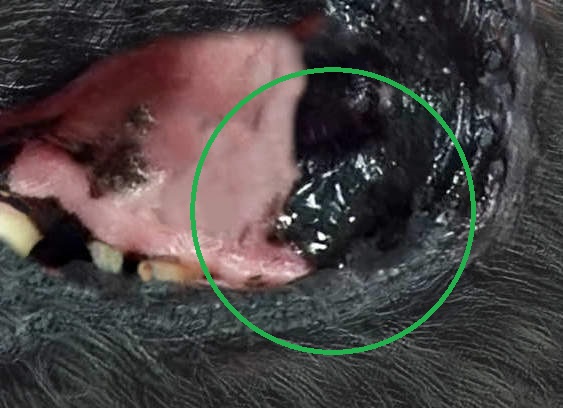
9. Squamous cell carcinoma
Squamous cell carcinomas affect the epidermal layer of the skin or mucosal tissues(gums). In the mouth, these tumors are often ulcerated and appear red in color due to inflammation. They are invasive and usually affect the underlying bone.
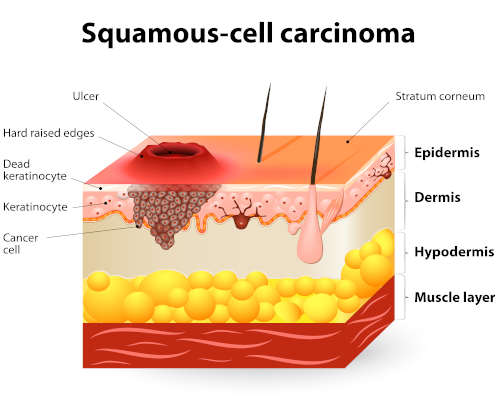
10. Fibrosarcoma
Fibrosarcomas in dogs will resemble squamous cell carcinomas. These cancerous tumors tend to be locally aggressive but have a lower rate of metastasis.
What are the most frequent causes of unusual gum growth?
Some lumps and bumps on the gums are rarely seen, while others are more common. Below, we will look at the most frequent cause of gum growth.
1. Gingival hyperplasia
Certain dogs are predisposed to gum overgrowth when they develop periodontal disease or receive treatments with certain drugs. This malady is most common in boxers, but it may also occur in bulldogs and other dog breeds.
Gingival hyperplasia may appear as grape-like growths which sometimes completely cover one or more of the teeth. The tissue may be red or pink and often bleeds when your dog eats. While the overgrowth usually starts with one tooth, it can spread throughout the mouth and may contribute to oral bacterial infections.
If the gum hyperplasia is a response to a medication, your veterinarian may be able to reverse the condition by changing to an alternative drug. When changing drugs is not an option, or the overgrowth is from another cause, treatment usually involves surgical removal of the excess gum tissue. The condition may reoccur.
2. Canker sores/ulcers
Mouth inflammation and ulcers usually occur as a hyperimmune response to plaque and bacteria on the teeth. The underlying causes of ulcers include:
- Inflammation
- Infection
- Injury
- Metabolic diseases like kidney disease or diabetes
- Diet or nutritional deficiencies
- Cancer
Signs of mouth sores include redness and swelling in the mouth, blood-tinged saliva, drooling, and bad breath. The condition is very painful, so your dog may have difficulty eating. If the disease is chronic, the skin can change in thickness and color.
Treatment for ulcers involves identifying and treating the underlying cause. It may include pain medications, antibiotics, antifungal medications, or other remedies. Supportive nutritional care may also be needed during the recovery period.
You can help your dog’s healing process at home by practicing good oral hygiene. Whether you brush your pup’s teeth regularly, use dental chews, or feed a prescription dental diet, take measures to keep bacteria and plaque minimal on your dog’s teeth.
3. Tooth root abscess
Tooth root abscesses occur when bacteria enter the root canal. When the root canal becomes exposed to microbial invaders, a pocket of infection develops beneath the gumline. Causes of tooth root abscesses include:
- Broken tooth
- Tooth trauma
- Periodontal disease
When dogs develop a tooth root abscess, the gums around the affected tooth are often red and swollen. You may also observe facial swelling below the eye, difficulty chewing food, and mouth pain., This condition is extremely painful and requires immediate attention. Treatment includes antibiotics, pain medication, and root canal therapy or tooth extraction depending on the severity of the abscess and tooth injury.
4. Dental cyst
Dental cysts develop when a tooth fails to erupt. Small and brachycephalic breeds are more predisposed to cysts because they usually have dental crowding in their mouths. Cysts are benign but can expand and damage neighboring teeth and the jaw. While any tooth can be affected, they usually occur in the premolars.
Because dental cysts can cause significant damage, it‘s important to catch and treat them early. Unfortunately, the damage may be done by the time the cyst grows large enough to notice. Treatment for oral cysts is the complete removal of the cyst, including the lining, to prevent a recurrence. When the growth is extensive, additional oral surgery including root canal, tooth extraction, or bone grafts may be required.
The best way to detect cysts is by scheduling regular oral exams(including counting teeth) for your puppy/young dog. Puppies should have 28 baby teeth, which usually erupt around 3-5 weeks of age. Adult teeth usually start to emerge around 4-5 months and are present by about 7 months.
5. Benign oral masses (epulis)
Peripheral odontogenic fibromas, acanthomatous ameloblastomas, and odontomas are classified as epulis. These benign oral masses arise from tissues that connect the teeth to the jaw bone. They are among the most common growths found in dogs’ mouths. While the cause is yet unknown, epulis tumors appear in middle-aged or older dogs(6+ years).
Signs of an epulis include:
- Pinkish, raised growth on the gums
- Drooling
- Displaced teeth
- Bleeding from the mass
- Difficulty chewing
- Tooth loss
- Foul-smelling breath
- Weight loss/loss of appetite
When you notice an epulis, you should schedule an appointment with your veterinarian. While they aren’t metastatic, some can be locally invasive and cause significant damage to surrounding tissues. They can also resemble some cancerous tumors.
Treatment involves surgical removal of the tumor and surrounding tissue to prevent further growth. Depending on the type of growth and tissue involvement, your veterinarian may follow up with cryosurgery, radiation treatments, or chemotherapy to ensure the destruction of the diseased tissue.
6. Malignant oral masses
The underlying cause of cancerous tumors including melanomas, squamous cell carcinomas, and fibrosarcomas is unidentified. However, the likely contributing factors include:
- UV light damage
- Age
- DNA mutations
- Breed dispositions – including Doberman, Poodle, Dachshund, and Retrievers
Signs of malignant masses can include:
- A lump or mass in the gums that may or may not be ulcerated
- Foul breath
- Bloody saliva or bleeding from the mouth
- Drooling
- Facial swelling/asymmetry
- Difficulty eating
- Resistance to opening the mouth
- Weight loss
Malignant growths don’t resolve and should be confirmed as early as possible. The sooner you find and treat cancerous tumors, the better the prognosis. Whenever possible treatment includes surgical removal of the mass and surrounding tissues. Depending on the type and stage/severity of the tumor, additional treatments may include radiation or chemotherapy.
Steps you can take at home to help your dog with a gum growth over the teeth
When you notice a growth on your dog’s gums, you should contact your veterinarian and describe its appearance and any symptoms you notice. As long as the tumor doesn’t call for immediate care, the doctor will either instruct you to monitor the lump at home or schedule an appointment for an oral examination and biopsy.
Some things you can do at home to help your dog include:
- Keep the teeth clean of plaque and tartar with regular brushing or dental treats/food
- Encourage your dog to keep drinking water
- Provide soft foods if chewing is painful or difficult to maintain proper nutrition
- Keep the lips and skin around the mouth clean and dry to avoid secondary infections
- Use an e-collar if your dog attempts to rub or paw at the face to avoid trauma
- Your veterinarian may also prescribe topical zinc-based gels or antimicrobials to help heal mouths sores
When should I call the vet?
If you notice abnormal growth or bumps on your dog’s gums, you should call your veterinarian. Although some tumors are benign, they can cause localized damage. Other growths point to a more serious condition such as cancer or underlying disease. The doctor can perform an oral examination and take a biopsy if needed to diagnose the problem.
You should head to the vet or emergency clinic immediately if:
- Your dog refuses to eat or cries out when he chews
- The mass ulcerates and bleeds profusely
- Your dog has facial swelling
- Your dog is weak or lethargic
How will my vet diagnose the bumps in my dog’s mouth, and what will it cost?
When you take your dog to your veterinarian the doctor will ask you questions about signs and symptoms and perform an physical and complete oral examination. The initial office visit will probably cost about $100-250 depending on whether sedation is needed to complete the oral exam. Once the doctor observes the growth’s characteristics, he may elect to:
- Take a tissue biopsy while under anesthesia(estimated cost is $300-600 or more)
- Take dental radiographs(estimated cost is $75-250)
- Run bloodwork(estimated cost is $100-200)
- Take chest X-rays (cost estimate for X-rays listed above)
- Take an abdominal ultrasound(estimated cost is 300-500)
- Take biopsies/aspirates of local lymph nodes(estimated cost is $25-200)
Frequently asked questions
Are gum bumps or growths always a sign of a serious condition?
Any time you see a bump or unusual growth on your dog’s gums, you should take it seriously. While there are some conditions that are not life-threatening or severe, you need a veterinary diagnosis to be sure. Additionally, some benign lumps can cause significant local damage.
Are gum bumps or growths typically painful?
Bumps and growths in your dog’s mouth are usually painful. When your furbaby has a gum tumor, whether benign or cancerous, he may demonstrate pain when he eats or when you attempt to open his mouth.
Can gum bumps or growths be cancerous?
While there are benign varieties of gum lumps and growths, some tumors are cancerous. Dogs can develop melanomas, fibrosarcomas, and squamous cell carcinomas in their mouths.
Disclaimer: This website's content is not a substitute for veterinary care. Always consult with your veterinarian for healthcare decisions. Read More.


Be the first to comment